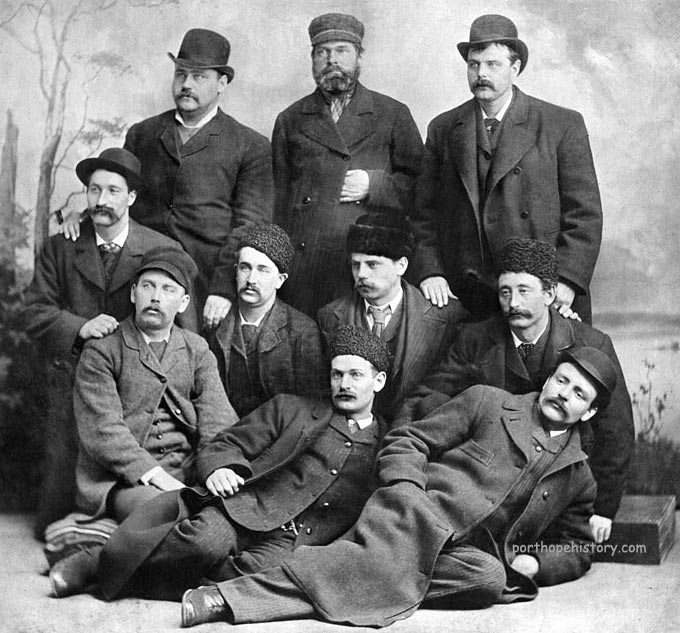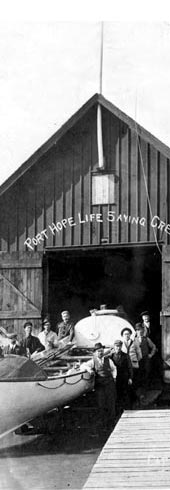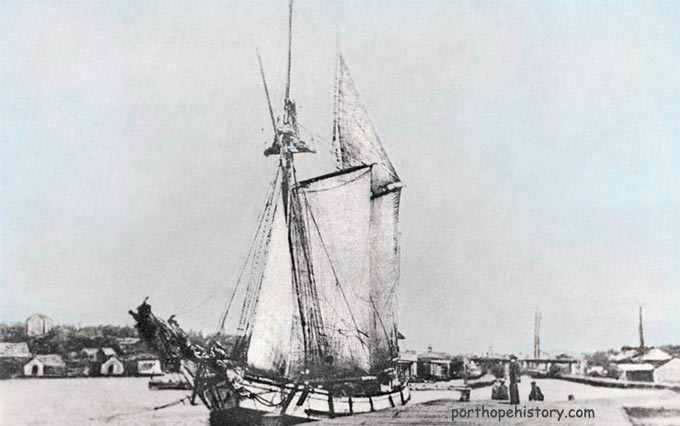| Port Hope Lakes Captains 1885 |

|
|
| hold cursor over a face to see the name | ||
|
from the Port Hope Guide & Weekly News Friday February 29, 1884 A Capt Harbottle was in town 3 or 4 days last week, examining and giving certificates to the masters and mates for this section. Below is a list of successful candidates. Master's certificate - William R Wakely. Mate's certificate - Thomas Wakely. |
||
|
from History of the Great Lakes Volume 2 by J B Mansfield Published Chicago: J H Beers & Co 1899 Captain William R Wakely, owner and master of the schooner Antelope, of Port Hope, Ontario, Canada, is one of the best navigators on the Great Lakes, and one of the most popular, being proverbial for his genial, affable and courteous manner. Our subject is a Canadian by birth, having first seen the light in 1854, at the place known as Cranberry Marsh, in the suburbs of Port Hope, Ontario, in which town he received his education. At the early age of eleven years, in 1865, he commenced sailing the lakes in the capacity of cook's mate, shipping out of Port Hope on the schooner Enterprise, and for two seasons he had charge of the galley, his excellent cooking earning for him a wide reputation on the lakes; while it is even recorded that several of the crew during his incumbency as 'chef' were thoroughly cured of chronic indigestion and dyspepsia, although he was three seasons on the Enterprise, during the last one serving before the mast, in other words as able seaman. In 1869 he shipped in the latter capacity on the schooner Otonabee, and remained thereon one season; next year he went before the mast on the brig Cavalier; following year shipped on the Annie Minnes, and was mate of her three seasons. On leaving the Annie Minnes, he went next year as sailing master on the schooner Little Kate, of Oakville, Ontario; from her, next season, he went as mate of the schooner W J Suffell; then took charge as captain of the schooner Wave Crest for five seasons, having bought an interest in her, which, however, he afterwards sold, and then retired from the lakes for six years. In the fall of 1888 Captain Wakely recommenced sailing, shipping on the schooner Delaware, remaining on her during the following spring, and sailed her for two seasons, then going on the schooner Jamieson, which he sailed three years. From the Jamieson he shipped on the schooner Flora Carveth, and sailed her four years in a good coarse freight business. Making an advantageous 'deal', he in the spring of 1897 became owner of the schooner Antelope, and is now sailing her as captain, trading principally on Lake Ontario. During his long experience as a mariner on the Great Lakes, in various capacities, Captain Wakely has on the whole met with good fortune. His principal mishap was when his schooner, Little Kate, went ashore on Snake island, near Kingston, Ontario. As she was loaded with peas, they had little difficulty in lightening her and towing her off, without the loss of any one on board. In fact, only one man in our subject's employ lost his life, a sailor named William Foster, who fell overboard in Oswego harbour, near the drawbridge, while lowering a boat, and was lost in the darkness. On another occasion, a seaman was struck by a sail and knocked overboard while he was out on the boom furling a jib; there was a pretty heavy sea on, and the vessel was pitching terribly, so watching his opportunity, the man, swimming for dear life in the water, grabbed the bobstays as the vessel pitched downward and climbed on deck. On yet another occasion, while our subject was captain of the Flora Carveth, a sailor was struck by lightning, and remained insensible for some time. Captain Wakely put into the nearest port and secured a physician, his prompt and humane action no doubt saving the man's life. In 1876 our subject married Miss Delilah Gertrude Mix, of Port Hope, daughter of I N Mix and Martha Mix, and five charming daughters, all bright, intelligent and well educated, grace this union, named respectively: Annie Maud, Lilian Gertrude, Mabel Vernon, Rose Edith and Tressia Gipsy Pearl. They are great companions to their parents, and in the hot days of the summer months they ofttimes accompany their mother on a short cruise on their father's vessel. In his political preference Captain Wakely has always been a strong Liberal, and has worked and voted in the ranks of the Reform party ever since he first got his franchise. In religious faith the entire family belongs to the Wesleyan Methodist Church, the young ladies being quite a power in the Port Hope church as well as social circles. The Captain owns one of the finest residences and other property in Port Hope, where the family is all held in the highest esteem. |
||
 Teddy McMahon's life-saving crew 1911. Captain Caldwell in front. |
from History of the Great Lakes by J B Mansfield Published Chicago: J H Beers & Co 1899 In 1882 the number of lives lost in these waters was 226; in 1883, it was 157; and in 1884, 160. Of the latter number 124 were lost at one time by the wreck of the steamship Daniel Steinman on the Atlantic coast, near Halifax. In November, 1882 the schooner Henry Folger was wrecked at Salmon Point, Lake Ontario, and eight persons drowned, all of whom, it was said, could have been saved had a lifeboat and crew been available. The Hon A W McLelan, who was then the Minister of Marine and Fisheries, and William Smith, the then Deputy Minister of Marine and Fisheries, both took a very active part in the matter and succeeded in organizing the nucleus of the present service under the authority of the government. Mr Smith was most strenuous in his efforts, making use of his Departmental staff and officers to get the several stations established and put in readiness to render service when required. The first station equipped was that at Cobourg, which was established November 7, 1882. Daniel Rooney was the coxswain, and had a crew of six men. His salary was $75 per annum, and he was also paid $1.50 for each drill, the drills taking place twice each month during the season of navigation. The crew were each paid $1.50 for each drill. This station was, and is, equipped with a self-righting and self-bailing boat of the Dobbins pattern, which is 25 feet long over all, and eight feet beam. It cost $575 and was made at Goderich, Ontario. Mr Rooney has been the coxswain ever since the establishment of the station. He was paid, as a reward for saving the lives of two fishermen April 4, 1890, $22. The station at Toronto was next established, March 1, 1883, William Ward being the coxswain appointed, who has held his position ever since. However, previous to the establishment of this government station there had been a voluntary life-saving crew on the island. The next station established was that at Wellington, Ont in 1883, with Hugh McCollough, coxswain. The station at Poplar Point, Prince Edward county, Ont was next established with Leroy Spafford as coxswain. Port Rowan, Ont was the next point at which a station was established, October 19, 1883 with J W McCall as coxswain. During the year 1885 it was decided by the government to invite tenders for the supply of twelve lifeboats, of a similar description to the self-righting and self-bailing boats placed in 1883 at Poplar Point and Wellington. Six of these twelve boats were built at Goderich, by William Marlton, and six at Dartmouth, NS by John Williams, at a cost, including outfit, of $575 each. These twelve boats, when completed, were located as follows: two on Sable island; and one each at Devil's island, Duncan's cove, Yarmouth and Scatarie, and one each at Cobourg, Collingwood, Goderich, Port Stanley, Toronto and Pelee island, the latter six being in the Province of Ontario. After this action the first station established was that at Port Stanley, Ont, June 25, 1885 with William Berry, coxswain. The station at Collingwood was established September 2, 1885 with P Doherty as coxswain. The station at Goderich was established October 21, 1886 with William Babb as coxswain. The station at Port Hope was established November 6, 1889 with C R Nixon as coxswain and a crew of six men. |
|
|
from History of the Great Lakes by J B Mansfield Published Chicago: J H Beers & Co 1899 Port Hope harbour is seven miles above Cobourg and twenty-three miles east one-half north of Darlington. The Port Hope Harbour & Wharf Co. was incorporated in 1829, and in 1832 obtained a loan from the government of $8,000. In 1852 this company sold the harbour to the town commissioners of Port Hope for $46,000. In 1864 authority was given to the Port Hope, Lindsay & Beaverton Railroad Co to acquire and hold the harbour. In 1857 two rows of piers were extended into the lake to the 13-foot contour, and a basin was thus formed at their inner or northern extremity. The harbour was perfectly safe for vessels from any wind northeast or west, but not from wind from any other direction because of the swell that then entered the basin. A lighthouse was erected on the east pier. Prior to Confederation the amount expended on this harbour by the government was $58,680, the works consisted of two piers, the eastern one extending 600 feet into the lake and the western one 480 feet. The width of the entrance was 104 feet, the piers reaching to the 13-foot contour at low water. There was a depth of 9 feet at the entrance to the harbour, which had an area of about three acres. In 1875/6 the western pier extended 150 feet and the eastern pier 120 feet, and the entrance was dredged to a depth of 13 feet. During the summer of 1882 the work of extending the eastern pier 100 feet more was commenced and considerable dredging also done. Up to June 30, 1882 the government had expended here $30,401. In 1882 the east pier was completed and a contract was entered into for the construction of a breakwater from the west pier for $11,261. The west pier was completed by September, 1883. The light here is called the Port Hope light and is about 110 feet from the extremity of the east breakwater, established in 1868. (There was a light on Peter Rock, or Gull Island, three miles east by south from Port Hope, a fixed white light supported by an octagonal stone structure, established in 1844.) |
||
|
|
||
| Captain Tom Fox's schooner the 'Flora Emma' | ||
|
|
